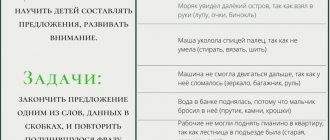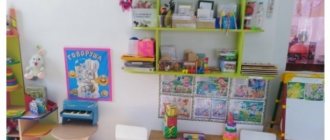Target. Help children understand the content of the picture; in the process of viewing, activate children’s speech; learn to finish words and small phrases.
Looking at the painting “Tanya and the Pigeons”
Progress of the lesson
The teacher shows the children the painting “Tanya and the Doves” (series “Our Tanya”, compiled by O. Solovyov), gives the opportunity to look at it and exchange impressions. Then he briefly talks about the content of the picture: “Tanyusha went for a walk and took with her bread and grains for the pigeons. While walking, she collected a beautiful bouquet of leaves.”
The teacher clarifies:
– What’s the weather like outside if Tanya is wearing warm clothes? Which ones exactly?
– Did the pigeons fly to Tanya themselves or did she call them? What did you call? (Guli-guli-guli, - choral and 3-4 individual answers). Why did Tanya call the pigeons?
- Where did Tanya get the leaves in the bucket? Did the bouquet turn out beautiful? (Beautiful.)
In conclusion, the teacher again tells the children about the picture: “Autumn has come. It became cold. Tanya put on leggings, boots and a warm jacket. She collected a bouquet of leaves and autumn flowers. The girl decided to put the bouquet in a bucket. I looked into it, and there were bread crumbs. Tanya brought them to the pigeons. “Gool, gulli, gulli!” – Tanya called and began to feed the birds that had flown to her.”
If there is time left and the guys are not tired, you can give them plumes to practice long, smooth exhalation through the mouth (this exercise is aimed at improving speech breathing).
Looking at the picture “Hide and Seek”
Progress of the lesson
The teacher shows the children the picture “Hide and Seek” and asks if they recognize the boy in blue pants and a blue cap. “How do you know him? – the teacher clarifies. “And why did he climb up Big Stump?” He listens to the children’s answers and says: “Baby, birds and little animals are playing hide and seek. The baby drives. He saw someone and shouted: “I see, I see!” What is the baby screaming?
Who do you think he saw? (It looks like a bunny. The bunny hid, and its white ears are sticking out.) Now tell me, who hid where?”
The teacher names the animal, and the children determine its location. (A squirrel - behind a tree, a woodpecker - into a hollow, a hedgehog - under a tree, a frog - under a leaf, mice - into flowers.)
“Can you show me what position Baby is standing in, how he smiles and holds his hand?” - the teacher is interested.
Then he summarizes the children’s observations: “The kid and his friends are playing hide and seek. Driven by the Kid. To see everyone, he climbed the Big Stump. Shouts: “I see, I see! You, bunny, are sitting in the bushes, and the squirrel is behind a tree. The woodpecker is in a hollow, and the hedgehog is in a hole-hole. The little mice froze in the flowers.” And the Kid would have been looking for the frog for a long time. She, green, cannot be seen at all under the large green leaf. Everyone is fine, everyone is having fun. And that is great!"
The teacher repeats the story, and the children help him by finishing the highlighted words.
Looking at the painting “Making a Car”
Progress of the lesson
“All children love to build cars, houses, and fortresses from cubes,” the teacher begins the lesson. “And I’ll show you these kids now.”
The teacher shows the children the picture “Making a car.” Children look at the picture and talk about what they noticed. The teacher listens to them without interfering.
“How did you guess that children were making a car? – the teacher clarifies. (Here are the wheels. The boy has the steering wheel, etc.)
The boy with the steering wheel in his hands is preoccupied with something, thinking about something, isn’t it? Maybe there is something missing in the car? (No cabin.)
The children don't know how to make a cabin. Can you advise where to put the cube that the boy in the green sweater is holding?
Well done! Now the car will have a cabin!
What is the girl doing? Right. She sweeps the floor in the back of the car with a large broom. Now the back is very clean.
Do you like these kids? I really, really like them too. It’s nice to look at kids who know how to play together without fighting.”
In conclusion, you can offer the children something like this: “The children decided to make a car. They made the body quickly. The body turned out beautiful: the kids took blue, red, yellow, green cubes. The children began to think about how to make a cabin.
While the boys were deciding where to put the next cube, the girl in the back swept the floor and kept it clean.
It’s a pleasure to watch friendly, hardworking kids.”




